Food Waste Management: Challenges and Solutions
VerifiedAdded on 2022/11/30
|5
|1464
|272
AI Summary
This article discusses the challenges and solutions of food waste management in organizations. It explores the environmental impact of food waste and the negative consequences on human well-being. The article also provides strategies to reduce food waste and increase profits for organizations.
Contribute Materials
Your contribution can guide someone’s learning journey. Share your
documents today.
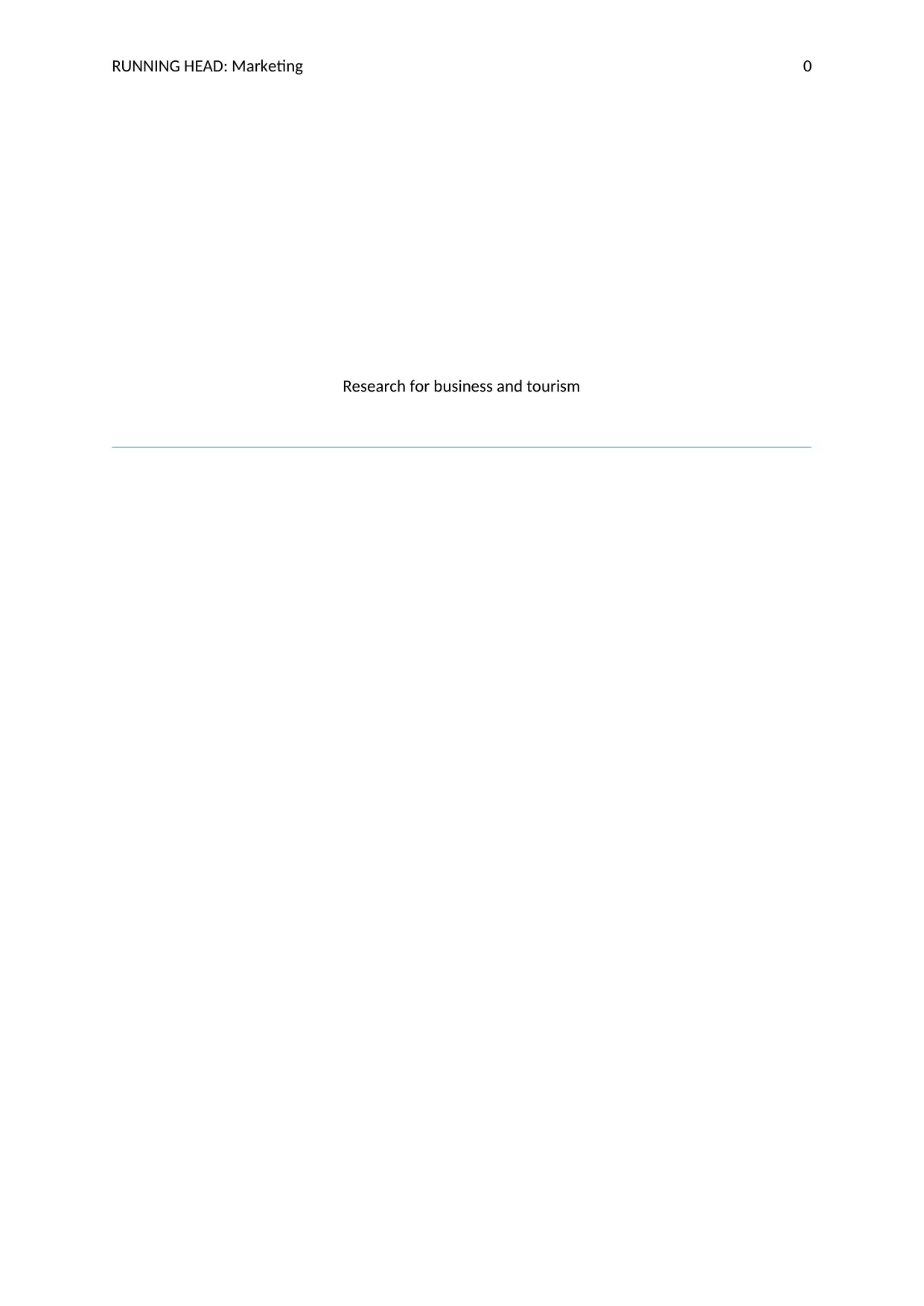
RUNNING HEAD: Marketing 0
Research for business and tourism
Research for business and tourism
Secure Best Marks with AI Grader
Need help grading? Try our AI Grader for instant feedback on your assignments.
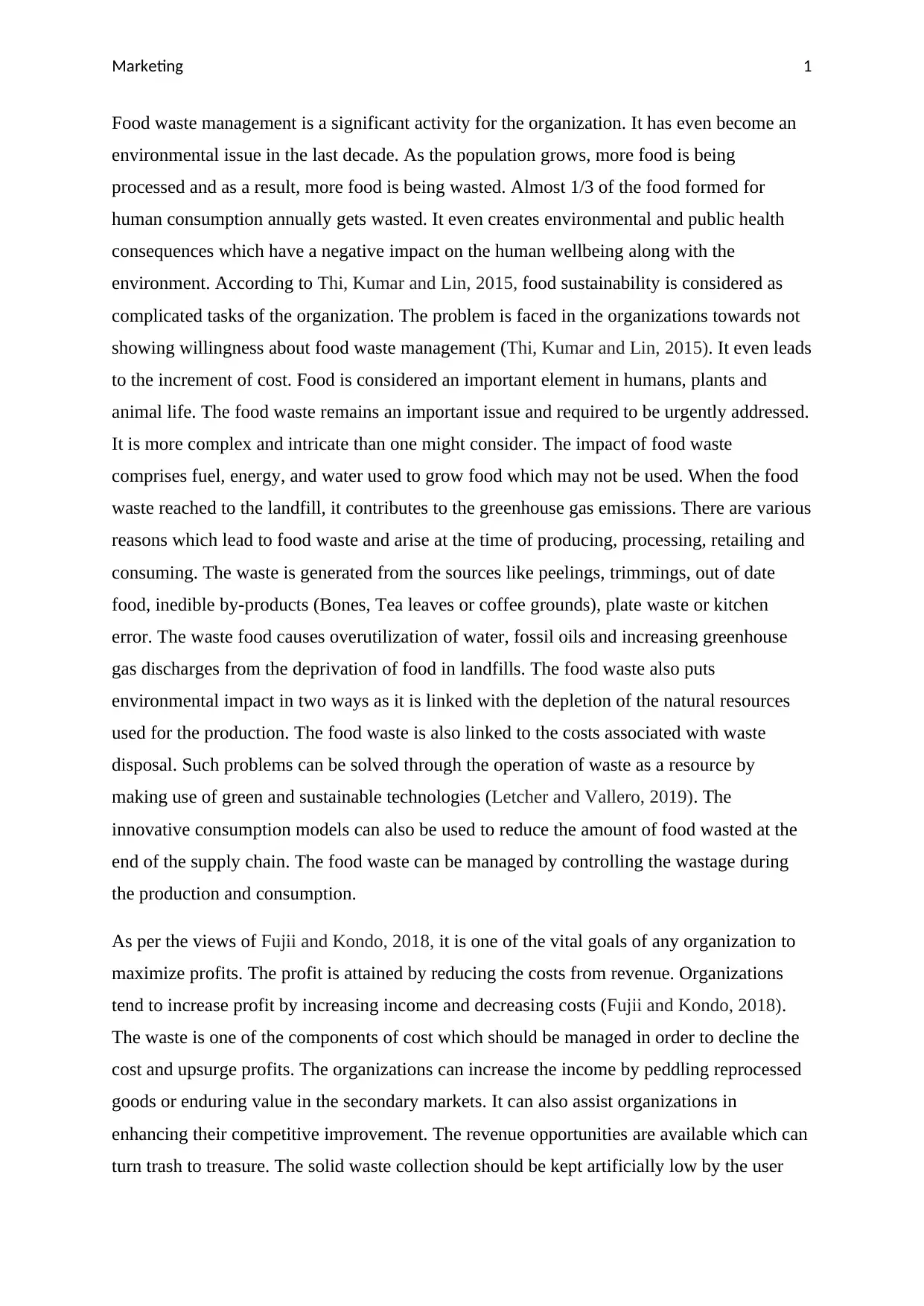
Marketing 1
Food waste management is a significant activity for the organization. It has even become an
environmental issue in the last decade. As the population grows, more food is being
processed and as a result, more food is being wasted. Almost 1/3 of the food formed for
human consumption annually gets wasted. It even creates environmental and public health
consequences which have a negative impact on the human wellbeing along with the
environment. According to Thi, Kumar and Lin, 2015, food sustainability is considered as
complicated tasks of the organization. The problem is faced in the organizations towards not
showing willingness about food waste management (Thi, Kumar and Lin, 2015). It even leads
to the increment of cost. Food is considered an important element in humans, plants and
animal life. The food waste remains an important issue and required to be urgently addressed.
It is more complex and intricate than one might consider. The impact of food waste
comprises fuel, energy, and water used to grow food which may not be used. When the food
waste reached to the landfill, it contributes to the greenhouse gas emissions. There are various
reasons which lead to food waste and arise at the time of producing, processing, retailing and
consuming. The waste is generated from the sources like peelings, trimmings, out of date
food, inedible by-products (Bones, Tea leaves or coffee grounds), plate waste or kitchen
error. The waste food causes overutilization of water, fossil oils and increasing greenhouse
gas discharges from the deprivation of food in landfills. The food waste also puts
environmental impact in two ways as it is linked with the depletion of the natural resources
used for the production. The food waste is also linked to the costs associated with waste
disposal. Such problems can be solved through the operation of waste as a resource by
making use of green and sustainable technologies (Letcher and Vallero, 2019). The
innovative consumption models can also be used to reduce the amount of food wasted at the
end of the supply chain. The food waste can be managed by controlling the wastage during
the production and consumption.
As per the views of Fujii and Kondo, 2018, it is one of the vital goals of any organization to
maximize profits. The profit is attained by reducing the costs from revenue. Organizations
tend to increase profit by increasing income and decreasing costs (Fujii and Kondo, 2018).
The waste is one of the components of cost which should be managed in order to decline the
cost and upsurge profits. The organizations can increase the income by peddling reprocessed
goods or enduring value in the secondary markets. It can also assist organizations in
enhancing their competitive improvement. The revenue opportunities are available which can
turn trash to treasure. The solid waste collection should be kept artificially low by the user
Food waste management is a significant activity for the organization. It has even become an
environmental issue in the last decade. As the population grows, more food is being
processed and as a result, more food is being wasted. Almost 1/3 of the food formed for
human consumption annually gets wasted. It even creates environmental and public health
consequences which have a negative impact on the human wellbeing along with the
environment. According to Thi, Kumar and Lin, 2015, food sustainability is considered as
complicated tasks of the organization. The problem is faced in the organizations towards not
showing willingness about food waste management (Thi, Kumar and Lin, 2015). It even leads
to the increment of cost. Food is considered an important element in humans, plants and
animal life. The food waste remains an important issue and required to be urgently addressed.
It is more complex and intricate than one might consider. The impact of food waste
comprises fuel, energy, and water used to grow food which may not be used. When the food
waste reached to the landfill, it contributes to the greenhouse gas emissions. There are various
reasons which lead to food waste and arise at the time of producing, processing, retailing and
consuming. The waste is generated from the sources like peelings, trimmings, out of date
food, inedible by-products (Bones, Tea leaves or coffee grounds), plate waste or kitchen
error. The waste food causes overutilization of water, fossil oils and increasing greenhouse
gas discharges from the deprivation of food in landfills. The food waste also puts
environmental impact in two ways as it is linked with the depletion of the natural resources
used for the production. The food waste is also linked to the costs associated with waste
disposal. Such problems can be solved through the operation of waste as a resource by
making use of green and sustainable technologies (Letcher and Vallero, 2019). The
innovative consumption models can also be used to reduce the amount of food wasted at the
end of the supply chain. The food waste can be managed by controlling the wastage during
the production and consumption.
As per the views of Fujii and Kondo, 2018, it is one of the vital goals of any organization to
maximize profits. The profit is attained by reducing the costs from revenue. Organizations
tend to increase profit by increasing income and decreasing costs (Fujii and Kondo, 2018).
The waste is one of the components of cost which should be managed in order to decline the
cost and upsurge profits. The organizations can increase the income by peddling reprocessed
goods or enduring value in the secondary markets. It can also assist organizations in
enhancing their competitive improvement. The revenue opportunities are available which can
turn trash to treasure. The solid waste collection should be kept artificially low by the user
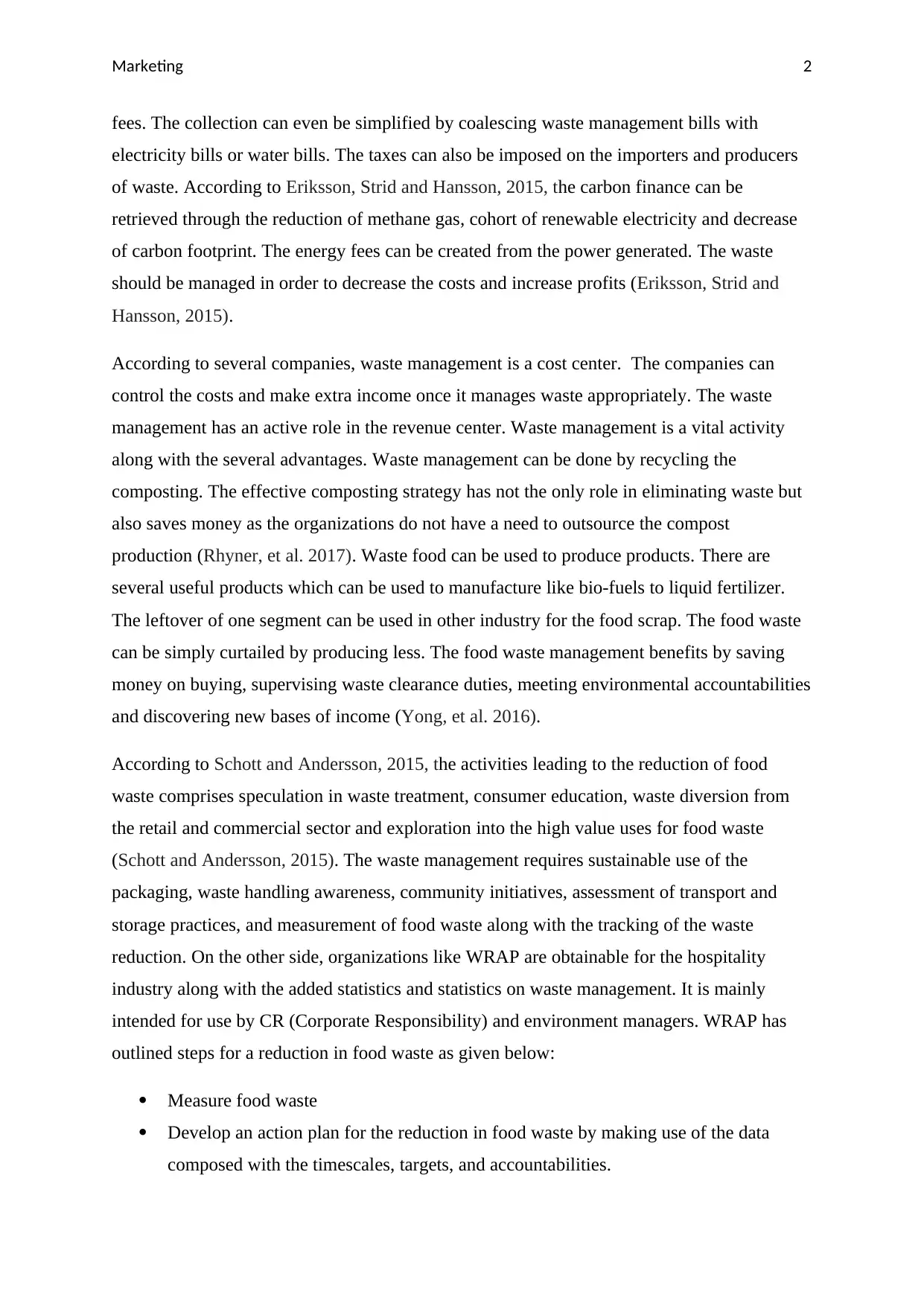
Marketing 2
fees. The collection can even be simplified by coalescing waste management bills with
electricity bills or water bills. The taxes can also be imposed on the importers and producers
of waste. According to Eriksson, Strid and Hansson, 2015, the carbon finance can be
retrieved through the reduction of methane gas, cohort of renewable electricity and decrease
of carbon footprint. The energy fees can be created from the power generated. The waste
should be managed in order to decrease the costs and increase profits (Eriksson, Strid and
Hansson, 2015).
According to several companies, waste management is a cost center. The companies can
control the costs and make extra income once it manages waste appropriately. The waste
management has an active role in the revenue center. Waste management is a vital activity
along with the several advantages. Waste management can be done by recycling the
composting. The effective composting strategy has not the only role in eliminating waste but
also saves money as the organizations do not have a need to outsource the compost
production (Rhyner, et al. 2017). Waste food can be used to produce products. There are
several useful products which can be used to manufacture like bio-fuels to liquid fertilizer.
The leftover of one segment can be used in other industry for the food scrap. The food waste
can be simply curtailed by producing less. The food waste management benefits by saving
money on buying, supervising waste clearance duties, meeting environmental accountabilities
and discovering new bases of income (Yong, et al. 2016).
According to Schott and Andersson, 2015, the activities leading to the reduction of food
waste comprises speculation in waste treatment, consumer education, waste diversion from
the retail and commercial sector and exploration into the high value uses for food waste
(Schott and Andersson, 2015). The waste management requires sustainable use of the
packaging, waste handling awareness, community initiatives, assessment of transport and
storage practices, and measurement of food waste along with the tracking of the waste
reduction. On the other side, organizations like WRAP are obtainable for the hospitality
industry along with the added statistics and statistics on waste management. It is mainly
intended for use by CR (Corporate Responsibility) and environment managers. WRAP has
outlined steps for a reduction in food waste as given below:
Measure food waste
Develop an action plan for the reduction in food waste by making use of the data
composed with the timescales, targets, and accountabilities.
fees. The collection can even be simplified by coalescing waste management bills with
electricity bills or water bills. The taxes can also be imposed on the importers and producers
of waste. According to Eriksson, Strid and Hansson, 2015, the carbon finance can be
retrieved through the reduction of methane gas, cohort of renewable electricity and decrease
of carbon footprint. The energy fees can be created from the power generated. The waste
should be managed in order to decrease the costs and increase profits (Eriksson, Strid and
Hansson, 2015).
According to several companies, waste management is a cost center. The companies can
control the costs and make extra income once it manages waste appropriately. The waste
management has an active role in the revenue center. Waste management is a vital activity
along with the several advantages. Waste management can be done by recycling the
composting. The effective composting strategy has not the only role in eliminating waste but
also saves money as the organizations do not have a need to outsource the compost
production (Rhyner, et al. 2017). Waste food can be used to produce products. There are
several useful products which can be used to manufacture like bio-fuels to liquid fertilizer.
The leftover of one segment can be used in other industry for the food scrap. The food waste
can be simply curtailed by producing less. The food waste management benefits by saving
money on buying, supervising waste clearance duties, meeting environmental accountabilities
and discovering new bases of income (Yong, et al. 2016).
According to Schott and Andersson, 2015, the activities leading to the reduction of food
waste comprises speculation in waste treatment, consumer education, waste diversion from
the retail and commercial sector and exploration into the high value uses for food waste
(Schott and Andersson, 2015). The waste management requires sustainable use of the
packaging, waste handling awareness, community initiatives, assessment of transport and
storage practices, and measurement of food waste along with the tracking of the waste
reduction. On the other side, organizations like WRAP are obtainable for the hospitality
industry along with the added statistics and statistics on waste management. It is mainly
intended for use by CR (Corporate Responsibility) and environment managers. WRAP has
outlined steps for a reduction in food waste as given below:
Measure food waste
Develop an action plan for the reduction in food waste by making use of the data
composed with the timescales, targets, and accountabilities.
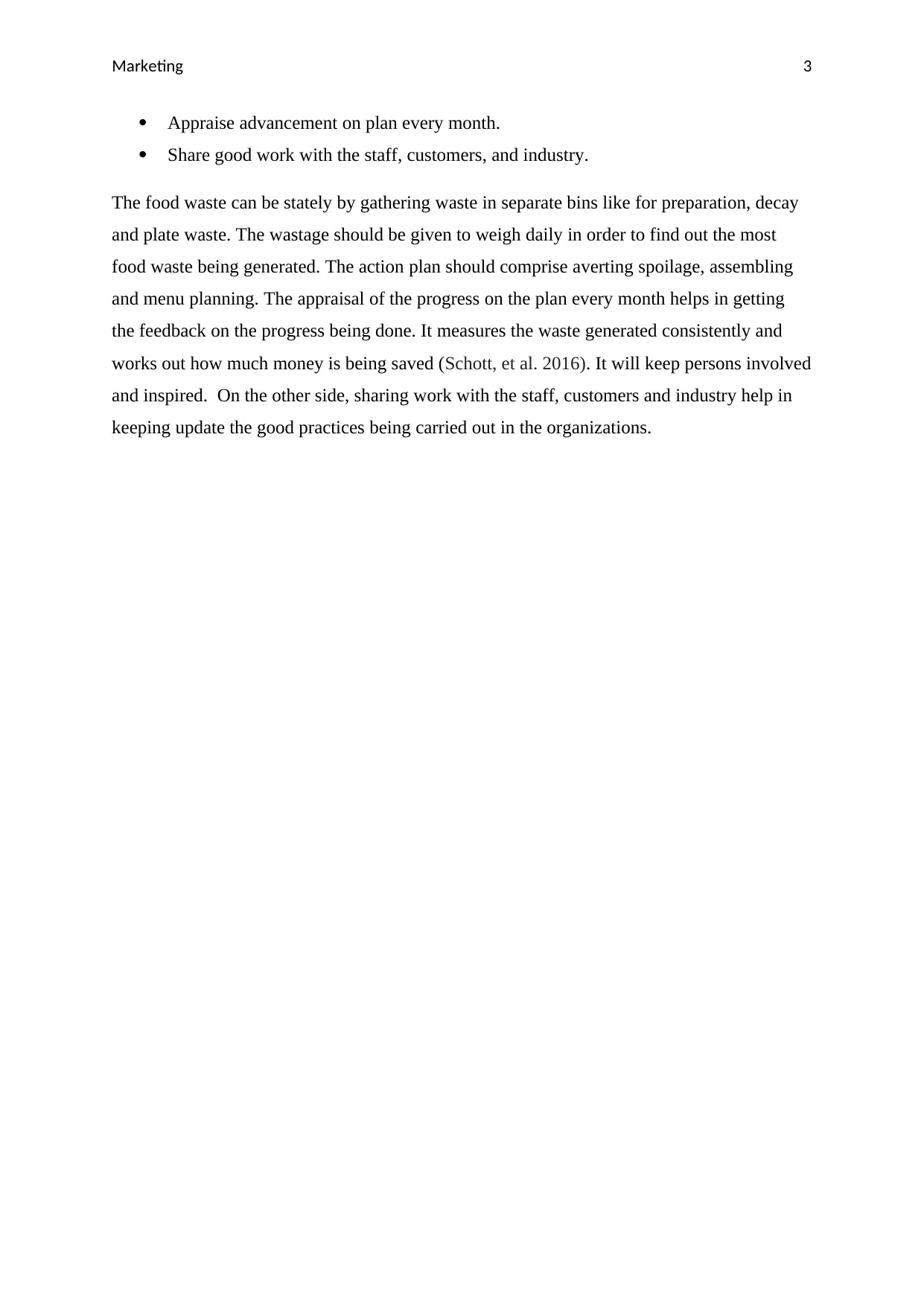
Marketing 3
Appraise advancement on plan every month.
Share good work with the staff, customers, and industry.
The food waste can be stately by gathering waste in separate bins like for preparation, decay
and plate waste. The wastage should be given to weigh daily in order to find out the most
food waste being generated. The action plan should comprise averting spoilage, assembling
and menu planning. The appraisal of the progress on the plan every month helps in getting
the feedback on the progress being done. It measures the waste generated consistently and
works out how much money is being saved (Schott, et al. 2016). It will keep persons involved
and inspired. On the other side, sharing work with the staff, customers and industry help in
keeping update the good practices being carried out in the organizations.
Appraise advancement on plan every month.
Share good work with the staff, customers, and industry.
The food waste can be stately by gathering waste in separate bins like for preparation, decay
and plate waste. The wastage should be given to weigh daily in order to find out the most
food waste being generated. The action plan should comprise averting spoilage, assembling
and menu planning. The appraisal of the progress on the plan every month helps in getting
the feedback on the progress being done. It measures the waste generated consistently and
works out how much money is being saved (Schott, et al. 2016). It will keep persons involved
and inspired. On the other side, sharing work with the staff, customers and industry help in
keeping update the good practices being carried out in the organizations.
Secure Best Marks with AI Grader
Need help grading? Try our AI Grader for instant feedback on your assignments.
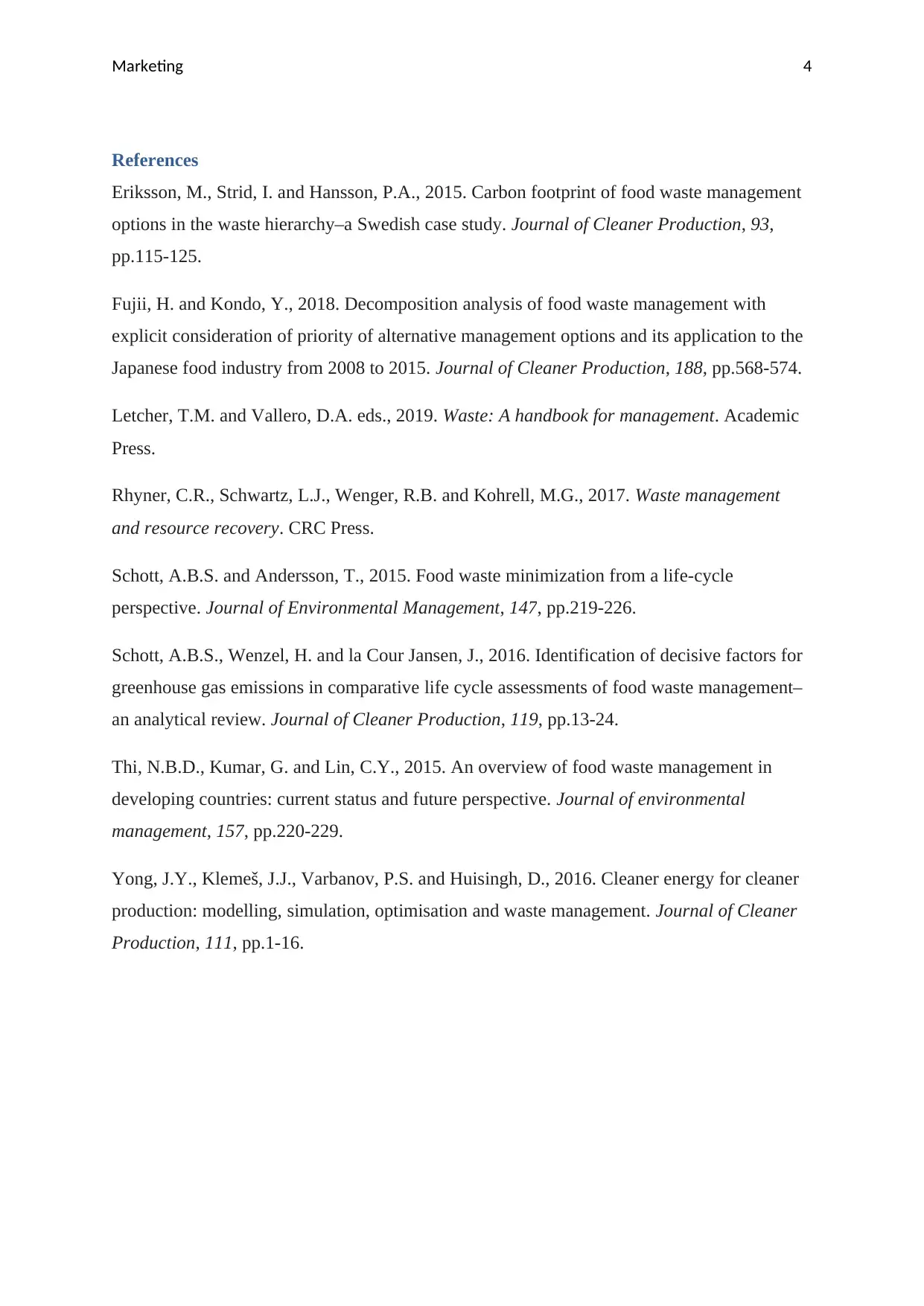
Marketing 4
References
Eriksson, M., Strid, I. and Hansson, P.A., 2015. Carbon footprint of food waste management
options in the waste hierarchy–a Swedish case study. Journal of Cleaner Production, 93,
pp.115-125.
Fujii, H. and Kondo, Y., 2018. Decomposition analysis of food waste management with
explicit consideration of priority of alternative management options and its application to the
Japanese food industry from 2008 to 2015. Journal of Cleaner Production, 188, pp.568-574.
Letcher, T.M. and Vallero, D.A. eds., 2019. Waste: A handbook for management. Academic
Press.
Rhyner, C.R., Schwartz, L.J., Wenger, R.B. and Kohrell, M.G., 2017. Waste management
and resource recovery. CRC Press.
Schott, A.B.S. and Andersson, T., 2015. Food waste minimization from a life-cycle
perspective. Journal of Environmental Management, 147, pp.219-226.
Schott, A.B.S., Wenzel, H. and la Cour Jansen, J., 2016. Identification of decisive factors for
greenhouse gas emissions in comparative life cycle assessments of food waste management–
an analytical review. Journal of Cleaner Production, 119, pp.13-24.
Thi, N.B.D., Kumar, G. and Lin, C.Y., 2015. An overview of food waste management in
developing countries: current status and future perspective. Journal of environmental
management, 157, pp.220-229.
Yong, J.Y., Klemeš, J.J., Varbanov, P.S. and Huisingh, D., 2016. Cleaner energy for cleaner
production: modelling, simulation, optimisation and waste management. Journal of Cleaner
Production, 111, pp.1-16.
References
Eriksson, M., Strid, I. and Hansson, P.A., 2015. Carbon footprint of food waste management
options in the waste hierarchy–a Swedish case study. Journal of Cleaner Production, 93,
pp.115-125.
Fujii, H. and Kondo, Y., 2018. Decomposition analysis of food waste management with
explicit consideration of priority of alternative management options and its application to the
Japanese food industry from 2008 to 2015. Journal of Cleaner Production, 188, pp.568-574.
Letcher, T.M. and Vallero, D.A. eds., 2019. Waste: A handbook for management. Academic
Press.
Rhyner, C.R., Schwartz, L.J., Wenger, R.B. and Kohrell, M.G., 2017. Waste management
and resource recovery. CRC Press.
Schott, A.B.S. and Andersson, T., 2015. Food waste minimization from a life-cycle
perspective. Journal of Environmental Management, 147, pp.219-226.
Schott, A.B.S., Wenzel, H. and la Cour Jansen, J., 2016. Identification of decisive factors for
greenhouse gas emissions in comparative life cycle assessments of food waste management–
an analytical review. Journal of Cleaner Production, 119, pp.13-24.
Thi, N.B.D., Kumar, G. and Lin, C.Y., 2015. An overview of food waste management in
developing countries: current status and future perspective. Journal of environmental
management, 157, pp.220-229.
Yong, J.Y., Klemeš, J.J., Varbanov, P.S. and Huisingh, D., 2016. Cleaner energy for cleaner
production: modelling, simulation, optimisation and waste management. Journal of Cleaner
Production, 111, pp.1-16.
1 out of 5
Related Documents
Your All-in-One AI-Powered Toolkit for Academic Success.
+13062052269
info@desklib.com
Available 24*7 on WhatsApp / Email
![[object Object]](/_next/static/media/star-bottom.7253800d.svg)
Unlock your academic potential
© 2024 | Zucol Services PVT LTD | All rights reserved.





